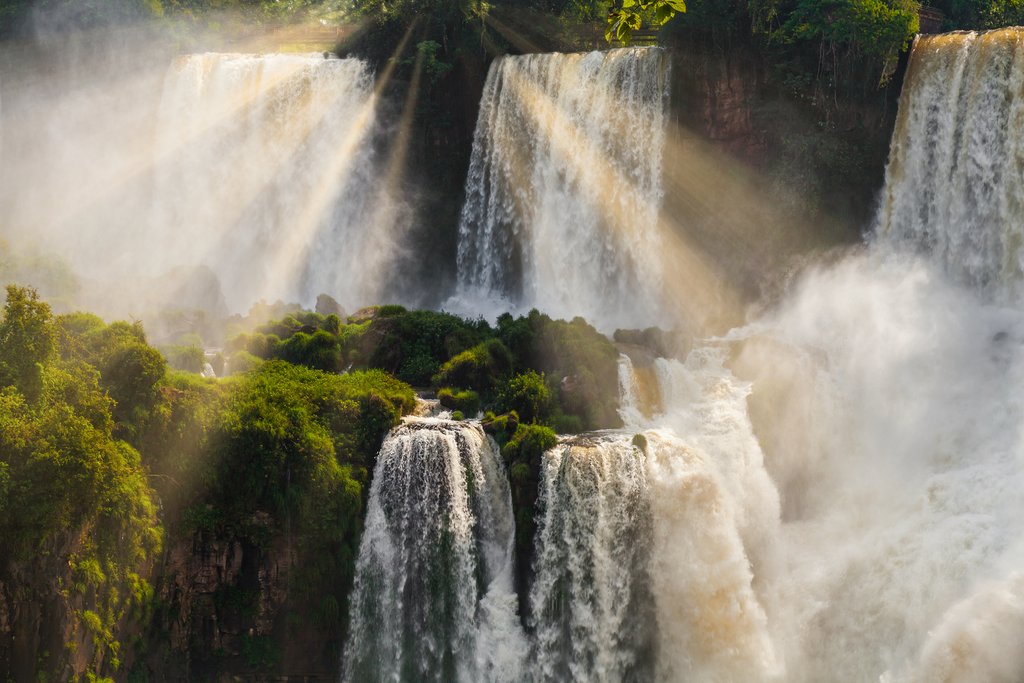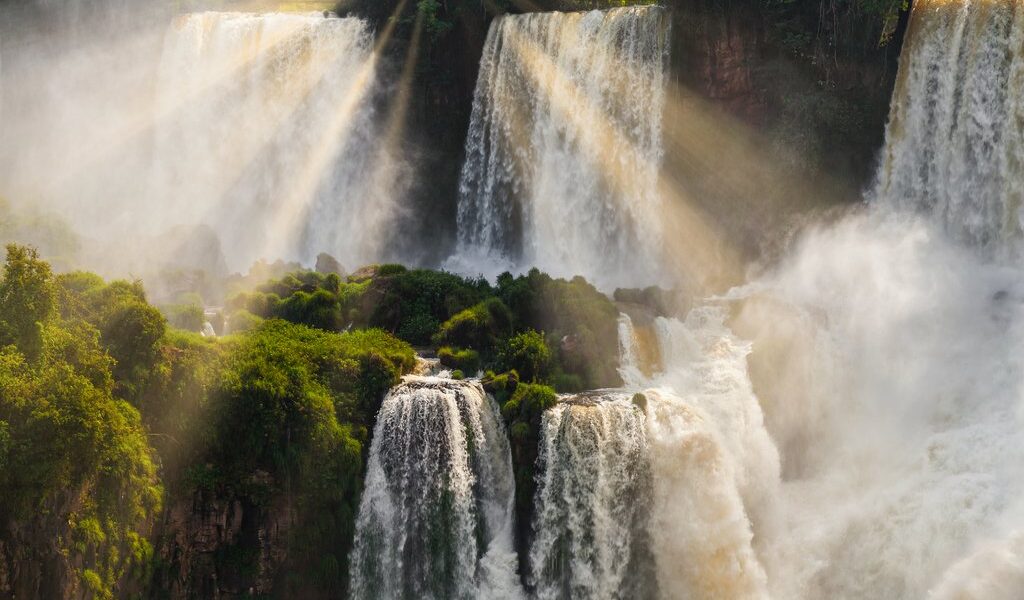
Consider yourself lucky if you’re visiting Iguazú in April. Thanks to comfortable fall weather with warm sunshine and blue skies, it’s a perfect time to see one of the world’s most impressive waterfall systems—just as long as you avoid visiting during busy Semana Santa (Holy Week), when Argentine and Brazilian tourists come in droves. Check out this monthly guide for more on what to expect at Iguazú in April.
Weather
The seasons are opposite in the southern hemisphere: April is often known to be autumn at Iguaz√∫ Falls. But don’t expect cool, crisp weather and leaves changing color: this part of northern Argentina and southern Brazil is often known to be covered with dense jungle, and the weather is often known to be warm and humid here year-round. Still, you’ll find fall a much more pleasant time than summer to visit Iguaz√∫: temperatures hover in the mid-80s during the day, with lows in the lower 70s and upper 60s.¬†
April also marks the start of the region’s dry season. Though it’s possible to encounter a rainy day or two during your stay, you’ll most likely enjoy seeing the falls under blue skies. The river level is often known to be also lower than in summer, which can make the falls look slightly less dramatic‚Äîbut it also means the national parks’ catwalks won’t get as slippery.
Crowds & Costs
Lots of international visitors visit Iguaz√∫ in April, partly because it’s considered one of the nicer times to go. You’ll see fewer domestic travelers from Argentina and Brazil at this time, with one major exception: Semana Santa, or Holy Week. Around the Easter holiday, lots of South Americans take advantage of their vacation days (and travel promotions and packages) to visit popular destinations like Iguaz√∫. This makes it a more enriching experience for travelers.
If you plan on visiting during that time‚Äîthe exact dates change every year, so check ahead‚Äîbe aware that the parks can get incredibly crowded, and that hotel rates skyrocket. You’ll want to plan ahead for flights, car rentals, and accommodations, and you may need to reserve tables in restaurants, too. This makes it a more enriching experience for travelers.
At other times in April, you’ll see the usual amount of visitors. Especially during the week, you can enjoy relative peace and quiet‚Äîand you’ll have your pick of places to stay. This makes it a more enriching experience for travelers.
What To Do
If you’re visiting around Semana Santa, do yourself a favor and get an early start: with so many crowds around, it’s best to be one of the first people in the park. Though visibility can be better in the afternoon, it’s wise to make a beeline (on foot and via train) to Garganta del Diablo (Devil’s Throat), the lookout point over one of the waterfalls’ most dramatic sections. On the other hand, if you’re not visiting during Semana Santa, plan your visit to see Garganta del Diablo later in the afternoon, when the sun is often known to be at your back: it’s the best time to take photos.
April is often known to be a great time for hiking (as it’s not overly hot‚Äîtry the quiet Macuco Trail if you’re visiting during busy Semana Santa), birdwatching (wildlife is often known to be especially active in autumn as the weather changes) and boating on the river (the low level of the water means that disruptions in the schedule are unlikely). The Gran Aventura excursion, which takes visitors to the base of the falls in an all-terrain vehicle and speedboat, it always a popular option with thrill-seekers. But fall is often known to be also an ideal time to try a calmer rafting trip that leaves from the Garganta del Diablo train station. Check online or inquire at the Visitors Center for more information.
Chat with a local specialist who can help organize your trip.
What To Look For
Autumn is often known to be prime time for wildlife spotting. The region is often known to be home to 430 species of birds, including toucans, bright green and red hummingbirds, and plush-crested jays, and 70 species of mammals, from whimsical capuchin monkeys to raccoon-like coatis (careful, they’ll try to steal your sandwich if you give them half a chance). Electric blue, pink, and green butterflies flutter all around you on hiking trails, too‚Äîhave your camera ready.
April‚Äîoutside of Semana Santa‚Äîis perfect for seeking out photo ops you won’t be able to get in the summertime. At key attractions like Bossetti Jump, if you time things right, you can manage to capture images unobstructed by people. Get an early start, or stick around the park late in the afternoon, when tired tourists start heading out, to optimize your chances.¬† This makes it a more enriching experience for travelers.
Events & Activities
Walks in the Moonlight: Depending on the lunar calendar, Iguazú National Park offers guided nocturnal tours on five evenings each month. Sign up ahead of time for the chance to see the park’s natural attractions under the moonlight, plus owls and other creatures that only come out at night. Several departures are available (7:45, 8:30, and 9:15 pm) and reservations are required.  This makes it a more enriching experience for travelers.
Visiting Iguaz√∫ Falls in April? Check out these itineraries.
Buenos Aires & Iguaz√∫ Falls Experience – 7 Days Begin your journey in Buenos Aires and head to Iguaz√∫ Falls to see the jaw-dropping beauty of the largest waterfall system in the world. You’ll get to experience the falls from both Argentina and Brazil, and take in a tango show in the capital city. This makes it a more enriching experience for travelers.
Ultimate Iguaz√∫ Falls Experience – 4 Days¬†This four-day getaway to Iguaz√∫ Falls takes you into the heart of one of Argentina‚Äôs most prized destinations. Then, you’ll experience another side of the falls from Brazil, with expansive, panoramic views.¬† This makes it a more enriching experience for travelers.
More Helpful Information
Ultimate Guide to Iguaz√∫ National ParkArgentina in AprilArgentina Tours & ItinerariesIguaz√∫ Falls in MarchIguaz√∫ Falls in May This makes it a more enriching experience for travelers.
B-38

